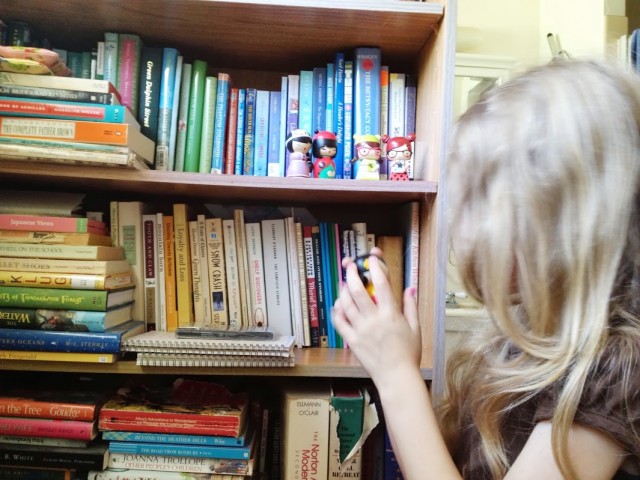
She’ll perch on a stool and play with the wooden dolls on my shelves by the hour. This is how Sunday afternoon unfolds: her soft doll-chatter murmuring beside me while I’m reading, studying, or (as was the case this weekend) cleaning out closets.
I see Joanna Trollope’s Other People’s Children peeking out from one of the stacks; I read it on (I think it was) Lesley’s recommendation and found it wholly absorbing, thoughtful, vivid, a bit sad. I liked it very much. Those shelves are a jumble of things I’m eager to read but haven’t had a chance yet (Green Dolphin Street, borrowed from my friend Carmen; The Light Between Oceans, a gift from my publisher last Christmas; Brideshead Revisited, because I still—still! still!!1!!—haven’t, among others) and books I love so much I need to keep them close. (A Far Cry From Kensington; One Man’s Meat; Dear Genius; etc. etc. etc.)
Notable picture-book reads of late: The Artist Who Painted a Blue Horse—a top-ten favorite of Rilla’s, and she’ll talk your ear off about the highlight colors in the paintings, if you like; Miss Suzy, back in frequent rotation; Open This Little Book, of which Huck cannot get enough; and to Huck for the very first time—oh! this particular milestone has been one of the most delightful I’ve experienced with each of the kids, one by one—Make Way for Ducklings. You can tell he’s the sixth child, not getting his full measure of McCloskey until the ancient age of four and a half. Scandal!
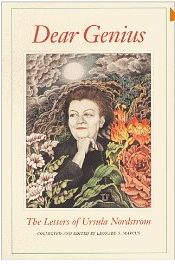 A book of letters I ought to have included in my ode to epistles and epistolaries the other day: Dear Genius: The Letters of Ursula Nordstrom. Miss Nordstrom, the pioneering editor behind Harper’s Department of Books for Boys and Girls from 1940 to 1973, was something of a genius herself. The list of children’s classics she was responsible for publishing is staggeringly long and awesome: Little Bear, Where the Wild Things Are, Goodnight Moon, Danny and the Dinosaur, Where the Sidewalk ends, Harold and the Purple Crayon, oh and a little thing called Charlotte’s Web—to name a very few.
A book of letters I ought to have included in my ode to epistles and epistolaries the other day: Dear Genius: The Letters of Ursula Nordstrom. Miss Nordstrom, the pioneering editor behind Harper’s Department of Books for Boys and Girls from 1940 to 1973, was something of a genius herself. The list of children’s classics she was responsible for publishing is staggeringly long and awesome: Little Bear, Where the Wild Things Are, Goodnight Moon, Danny and the Dinosaur, Where the Sidewalk ends, Harold and the Purple Crayon, oh and a little thing called Charlotte’s Web—to name a very few.
Dear Genius is a collection of letters she wrote to authors, illustrators, reviewers, even parents and children who had written with responses to her books. She is unfailingly poised, charming, and insightful, even when responding to criticism. And her voice, oh her wonderful voice! Her letters are simply crammed with personality—she is wry, teasing, incisive, direct, and altogether brilliant.
Her editorial letters provide a fascinating look at the history of children’s publishing in America, both on the grand scale of publishing trends and literary vision, and on the micro scale of word choices for a single line of a specific book. For instance, in a 1957 letter to Syd Hoff about Danny and the Dinosaur, an early “I Can Read” book for beginning readers:
I think you should just say “One day Danny went to the museum.” (He didn’t actually want to “see how the world looked a long, long time ago,” as you put it, do you think? Very unchildlike. He might have wanted to go to see the dead mummies, or other specific things in a museum, but I wouldn’t mention that here because you mention it on following pages. So just have a simple statement on this first page. “One day Danny went to the museum.”) It is pretty short and if you can think of one more short sentence for this page by all means add it. I can’t come up with any suggestion myself. Page 8: You’ll have to simplify what he saw on this page. NOT THAT I WANT YOU TO GET SELF-CONSCIOUS ABOUT “I CAN READ.” I told you I wanted you to let me worry about that aspect and that’s all I’m doing now. You could just say “He saw Indians. He saw bears. He saw…” I haven’t been in a museum in 150 years and can’t think of anything else, but you can.
Or, in September 1963:
Maurice, before I sent the paste-up I went through it, rereading the words, and looking at the pictures again. It is MOST MAGNIFICENT, and we’re so proud to have it on our list. When you were much younger, and had done only a couple of books, I remember I used to write you letters when the books were finished, and thank you for “another beautiful” job—or some such dopiness. Now you’re rich and famous and need no words of wonder from me. But I must send them, anyhow, when I look through Where the Wild Things Are. I think it is utterly magnificent, and the words are beautiful and meaningful, and it does just wan
Sarah's talked this week about herself, her cats, her book, maps, and biscuits and bacon. Before saying toodle-oo today, because editors are such an important part of the book-making process, she wanted to share her thoughts about Ursula Nordstrom, the legendary director of the HarperCollins children's books division from 1940 to 1973.
I didn't really understand what book editors do, or how they feel about 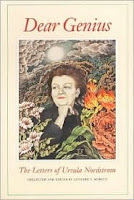 their work, until my own editor sent me Dear Genius, which is a book of letters from Ursula Nordstrom to many of the authors she worked with, including E.B. White, Margaret Wise Brown, Maurice Sendak, M.E. Kerr, Russell and Lillian Hoban, etc, etc, etc. UN had her hand in so many of the best-loved children's books published during those years; she had a vision, and she stuck to it.
their work, until my own editor sent me Dear Genius, which is a book of letters from Ursula Nordstrom to many of the authors she worked with, including E.B. White, Margaret Wise Brown, Maurice Sendak, M.E. Kerr, Russell and Lillian Hoban, etc, etc, etc. UN had her hand in so many of the best-loved children's books published during those years; she had a vision, and she stuck to it.
The book was a revelation, really. Publishing is big business, right? HarperCollins, as far as I know, is owned by a huge multinational corporation. And we writers are aware of the tension between the business and the book. We love our own books, and we worry about whether they're going to sell well enough to make our publisher happy. This tension is nothing new; UN felt it, and referred angrily at the end of her career to "those tiny, tiny persons who live on the well-known bottom line."
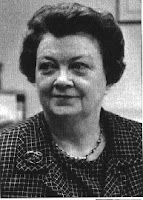 As director, UN had to be aware of the bottom line, but she quite often fell in love with a book or with a piece of artwork. "There are a lot of us in publishing," she said, "who are just as romantic, or perhaps more romantic, about books than many of the authors and artists." Reading a book sent to her by one of her authors, she describes herself: "I sit here in shimmering happiness over such a lovely manuscript."
As director, UN had to be aware of the bottom line, but she quite often fell in love with a book or with a piece of artwork. "There are a lot of us in publishing," she said, "who are just as romantic, or perhaps more romantic, about books than many of the authors and artists." Reading a book sent to her by one of her authors, she describes herself: "I sit here in shimmering happiness over such a lovely manuscript."
Once an author or artist was 'hers,' she became his or her champion. She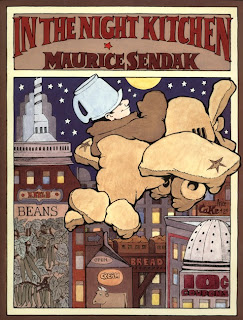 discovered Maurice Sendak when he was designing shop windows at FAO Schwartz! She defended his controversial In the Night Kitchen (in the pictures, the little boy is naked) against prudish readers who wanted to censor the book and described one of her responses as leaving 'blood all over the keyboard.' She describes herself as "one who has fought, bled, and practically died to do good books whether or not they were going to be immediately profitable."
discovered Maurice Sendak when he was designing shop windows at FAO Schwartz! She defended his controversial In the Night Kitchen (in the pictures, the little boy is naked) against prudish readers who wanted to censor the book and described one of her responses as leaving 'blood all over the keyboard.' She describes herself as "one who has fought, bled, and practically died to do good books whether or not they were going to be immediately profitable."
Sometimes her 'geniuses' didn't produce the work they were contracted to do. UN was a master of gentle flattering persuasion—dear genius, the world needs your beautiful book! As deadlines pass, she prods gently, and sometimes with dramatic desperation. Kay Thompson was supposed to do another Eloise book for Harper, but she didn't turn the book in on time, and stopped answering letters or phone calls. UN wrote, "I wonder if I'm dead and I don't realize it, and that's why you can't get in touch with me." And Edward Gorey made her nuts! After repeated delays, she said she hoped Harper could publish the book "before a truck knocks me down and kills me."
She was passionate about her books and her artists and authors. And I think that tradition in publishing is still alive. Editors still buy books because they fall in love with them. Thanks to them, readers can find books that they, too, can fall in love with.
Have you ever read a book that made you feel "shimmering happiness"? I bet its editor felt that way, too.
We'll leave you pondering that question while we thank Sarah for her enlightening post on editors and for a divine debut week. Best of luck, Sarah!
P.S. Everyone be sure to check our HarperCollins's new website for THE MAGIC THIEF, it just launched.

Adam Canfield is back in the sequel to Adam Canfield of the Slash. Still overbooked with sports, homework, and after school activities, Adam is rushed as usually, but still working on investigations for the paper. After being mugged while shoveling snow, Adam’s co-editor and reporters come up with the idea of doing a story on bullying. But Adam has bigger things on his mind and more stories to investigate. But he gets into a slump and finds it hard to get up the energy to do any reporting. Will this be the end of Adam? Luckily Jennifer, his co-editor, is there to spur him on and soon Adam is back in action showing that the science fair is not fair and a major business is trying to ruin the town forever.
Once again, Adam shows that a small school paper does have the power to change things, but this time they might have bitten off more than they can chew. The book ends in a cliff hanger and it will be interesting to see what happens next. I can’t wait! I was pleasantly surprised when I discovered a sequel toe Adam Canfield of the Slash. I thought it was a stand alone novel. These are great books and the characters are so three dimensional you feel like you might know them in your life. Winerip accurately captures the life of a middle school student and the stresses and pressures put upon them. A great story and one that will be a sure favorite with kids.










Every post was fun, Sarah! I'm off to order DEAR GENIUS. :)
What a wonderful blog post!
Teri